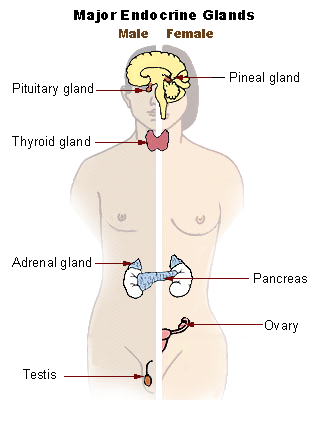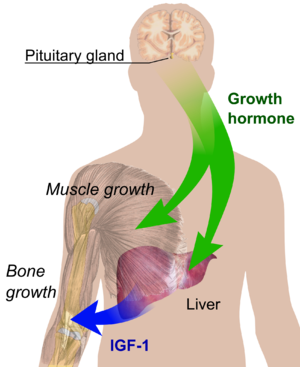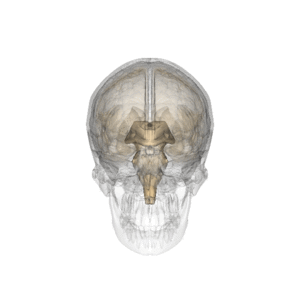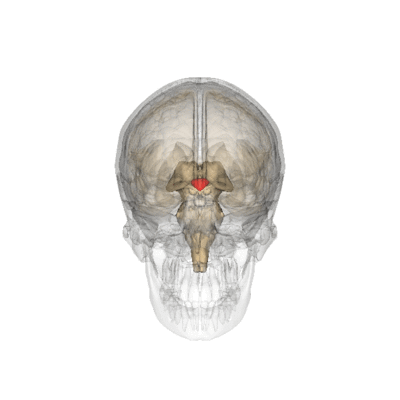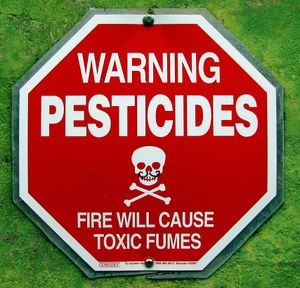Hormones
Original Editor - Lucinda hampton
Top Contributors - Lucinda hampton and Kim Jackson
Hormones[edit | edit source]
A hormone is a chemical transmitter substance produced by cells of the body and transported by the bloodstream to the cells and organs on which it has a specific regulatory effect. They are an integral part of the endocrine system.
- Hormones act as chemical messengers to body organs, stimulating certain life processes and retarding others. Growth, reproduction, control of metabolic processes, sexual attributes, and even mental conditions and personality traits are dependent on hormones[1].
- The word "hormone" comes from a Greek word that means "to spur on." This reflects how hormones act as catalysts for chemical changes at the cellular level that are necessary for growth, development and energy.[2]
The Endocrine System[edit | edit source]
- A collection of glands and organs that produce and regulate hormones in the bloodstream to control many functions of the body.
- Hormones that are made in the body's glands work like messages. Just like with other types of communication, the proper message must reach its intended destination to be effective. For this reason, certain hormones are designed to end up only at certain cells, called target cells.
- This system overlaps with the nervous system and exocrine system, and its responsibilities include metabolism, growth and sexual development. Most animals that have advanced physiology, such as vertebrates and crustaceans, have an endocrine system.[3]
Steroid and Peptide Hormones[edit | edit source]
Steroid and peptide hormones are two types of hormones in the body. The main differences
- Steroid hormones: lipid-soluble and can diffuse easily into the cell membrane of the target cell to bind to the receptors inside the cytoplasm to act as second messengers
- Peptide hormones: water-soluble and connects with receptors at the membrane as it can’t diffuse through the membrane. Since peptide hormones bind to receptors at the surface, their effect is faster than steroid hormones.[4]
Glands[edit | edit source]
Unlike exocrine glands(sweat, salivary), endocrine glands secrete their respective substances directly into the bloodstream rather than through a duct. These endocrine glands belong to the body’s control system and they produce hormones which help to regulate the functions of cells and tissues. The endocrine system involves many organ systems and hormones, many of which are still being investigated and understood.
The major glands of the endocrine system are the listed below:
- Pituitary gland: Enclosed deep within the skull (the size of a pea). Hangs on a stalk at the base of the brain. It consists of an anterior portion that produces hormones and a posterior portion that has many neural links. Regarded as the master gland as it controls the functions of all the other glands (such as the adrenal, thyroid glands) in the endocrine system. The pituitary gland stimulates the adrenal gland to secrete cortisol, a steroid hormone controls a range of activities from controlling the body’s metabolism to stimulating blood pressure. The pituitary gland also secretes prolactin, which stimulates the production of milk.
2. Pineal gland: Located between the two halves of the brain. It produces melatonin which influences the body's Circadian Rhythm (the body’s sleep/wake cycle).
3. Thyroid gland: Found at the front of the neck, low in the throat, between the windpipe. Brownish red, it has blood vessels coursing through it. It secretes hormones that are collectively called thyroid hormones. The most prominent are T3 and T4, which influence the body’s rate of metabolism.
4.
Parathyroid glands: Consist of four small glands that are located behind the thyroids in the neck. They influence the calcium levels in the body by producing a hormone called Parathyroid Hormone. Sometimes, when the gland produces excess parathyroid hormones, it can have negative effects such as brittle bones and kidney stones.
5. Adrenal glands: Sit atop the kidneys and are no larger than a walnut. These glands produce over 150 hormones that regulate different functions in the body. The most well known is Adrenaline, which triggers the flight or fight response. In other words, this is a stress hormone that helps the organism to either face a dangerous situation or to avoid it altogether. It does this by:
- Increasing blood sugar levels
- Increasing the blood supply to the muscles, particularly to the limbs.
- Dilating the pupils
- Increasing the heart rate
- Tightening the jaw muscles.
6. Pancreas: Exocrine as well as an endocrine gland (sits behind the stomach). It is roughly 6 inches long and rather flat. The pancreas has two primary roles to play:
7. Gonads: The ovaries are specific to females and are located in the pelvic cavity. While the testes are specific to males. Ovaries produce estrogen that is important for reproduction and female sex characteristics. Testes produce testosterone that is responsible for male sex characteristics. Also, it results in increased muscle mass and body hair.
To a lesser degree, organs such as the heart, lungs and stomach are involved in hormone management.
Hypothalamus[edit | edit source]
The hypothalamus is a part of the brain that has a vital role in controlling many bodily functions including the release of hormones from the pituitary gland (some people don’t consider it a gland)[6]:
- Located on the undersurface of the brain. It lies just below the thalamus and above the pituitary gland, to which it is attached by a stalk. It is an extremely complex part of the brain containing many regions with highly specialised functions. In humans, the hypothalamus is approximately the size of a pea and accounts for less than 1% of the weight of the brain.
- One of the major functions of the hypothalamus is to maintain homeostasis, i.e. to keep the human body in a stable, constant condition.
- Responds to a variety of signals from the internal and external environment including body temperature, hunger, feelings of being full up after eating, blood pressure and levels of hormones in the circulation.
- Responds to stress and controls our daily bodily rhythms such as the night-time secretion of melatonin from the pineal gland and the changes in cortisol (the stress hormone) and body temperature over a 24-hour period.
- Collects and combines all above information and puts changes in place to correct any imbalances[7].
Problems of the endocrine system[edit | edit source]
Numerous problems can occur in the endocrine system. These can be considered as excessive or deficient hormone production. Endocrine organs are also prone to tumours (adenomas) which can over produce hormones. See Metabolic/Endocrine Disorders
- Hyperthyroidism: occurs when the thyroid gland makes more thyroid hormone than necessary. This can be caused by a range of things, including autoimmune conditions. eg. Graves disease is an autoimmune disorder and common form of hyperthyroidism.
- Hypothyroidism: occurs when the thyroid doesn’t produce enough thyroid hormone.
- Cushing syndrome: occurs due to high levels of the hormone cortisol.
- Addison disease: occurs when the adrenal glands don’t produce enough cortisol or aldosterone.
- Diabetes
- Estrogen dominance: changes in sleep patterns, changes in weight and appetite, higher perceived stress, slowed metabolism
- Polycystic Ovarian Syndrome (PCOS): infertility, weight gain, higher risk for diabetes, acne, abnormal hair growth
- Low estrogen: low sex drive, reproductive problems, menstrual irregularity, changes in mood .
- Low testosterone: erectile dysfunction, muscle loss, weight gain, fatigue, mood-related problems[8]
Endocrine Disruptors[edit | edit source]
Endocrine disruptors are chemicals that can interfere with endocrine systems at certain doses. These disruptions can cause cancerous tumors, birth defects, and other developmental disorders. Any system in the body controlled by hormones can be derailed by hormone disruptors. Specifically, endocrine disruptors may be associated with the development of learning disabilities, severe attention deficit disorder, cognitive and brain development problems deformations of the body that includes breast cancer, prostate cancer, thyroid and other cancers; sexual development problems such as feminizing of males or masculinizing effects on females, etc.[9]
There are some 800 chemicals suspected as being capable of interfering with hormone receptors, synthesis, conversion or cell signalling during critical periods of cell and organ development. Some of these occur naturally, but many are synthetic and used in agriculture (growth promoters, pesticides and wetting agents), plasticizers, as flame-retardants in textiles, clothing and furnishings, non-stick coatings, food additives, electronics and cosmetics, personal care products and perfumes.[10]
References[edit | edit source]
- ↑ Med dictionary Hormone Available from:https://medical-dictionary.thefreedictionary.com/Hormone (accessed 24.12.2020)
- ↑ Wisegeek Hormones Available from: https://www.wisegeek.com/what-are-hormones.htm(accessed 24.12.2020)
- ↑ Wise geek What is the endocrine system Available from:https://www.wisegeek.com/what-is-the-endocrine-system.htm (accessed 24.12.2020)
- ↑ Bodytomy Steroid vs Peptide hormone Available from:https://bodytomy.com/how-is-steroid-hormone-different-from-peptide-hormone (accessed 25.12.2020)
- ↑ byjus Endocrine Glands Available from: https://byjus.com/biology/endocrine-glands/ (accessed 24.12.20200
- ↑ Healthline endocrine glands Available from:https://www.healthline.com/health/the-endocrine-system#organs (accessed 24.12.20200
- ↑ Know your hormones Glands Available from:https://www.yourhormones.info/glands/hypothalamus/ (accessed 24.12.2020)
- ↑ Practo Can Physiotherapy Help Balancing Hormones? How It Helps PCOD? Available from:https://www.practo.com/healthfeed/can-physiotherapy-help-balancing-hormones-how-it-helps-pcod-32144/post (accessed 25.12.20200
- ↑ Conference series Endocrine disrupting signals Available from:https://endocrinology.endocrineconferences.com/events-list/edcs-endocrine-disrupting-chemicals (accessed 25.12.2020)
- ↑ The conversation Endocrine disrupting chemicals – is there any larger, more neglected health problem? Available from:https://theconversation.com/endocrine-disrupting-chemicals-is-there-any-larger-more-neglected-health-problem-70586 (accessed 25.12.2020)
